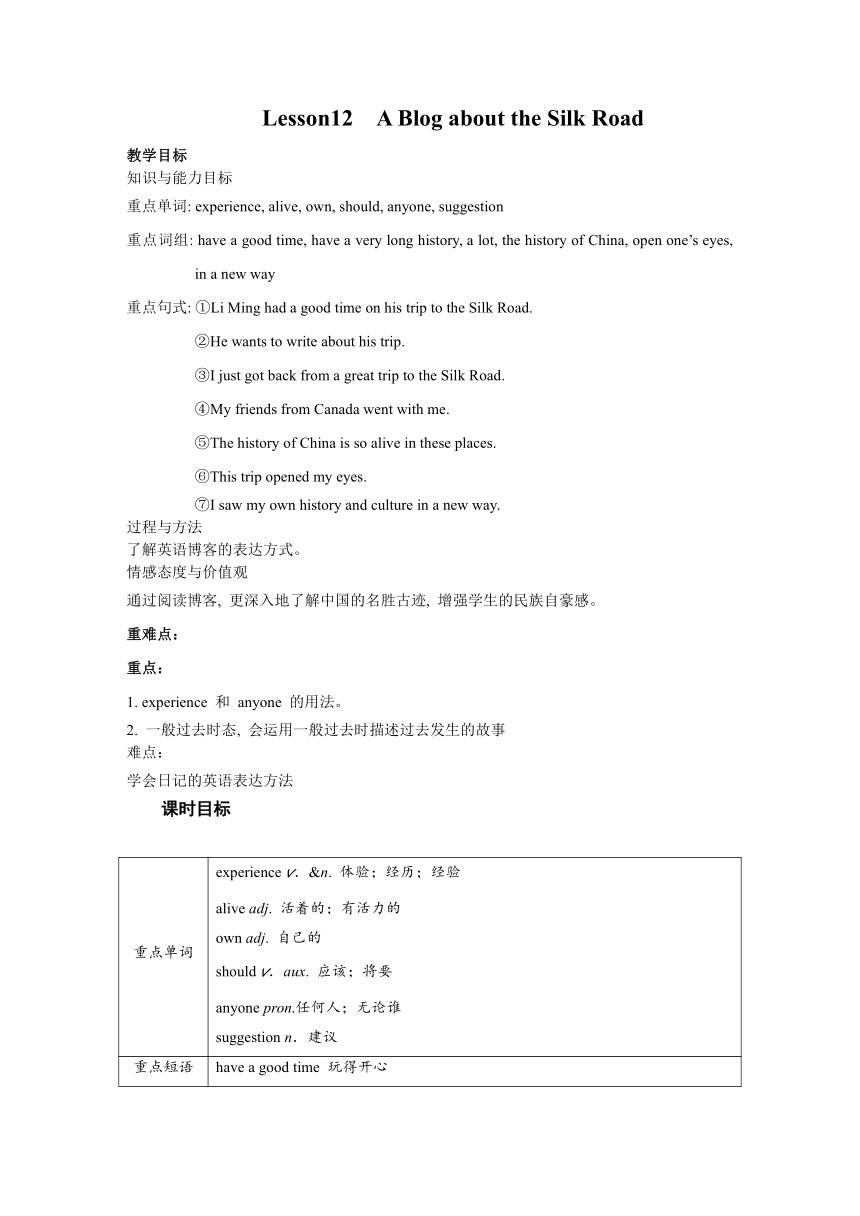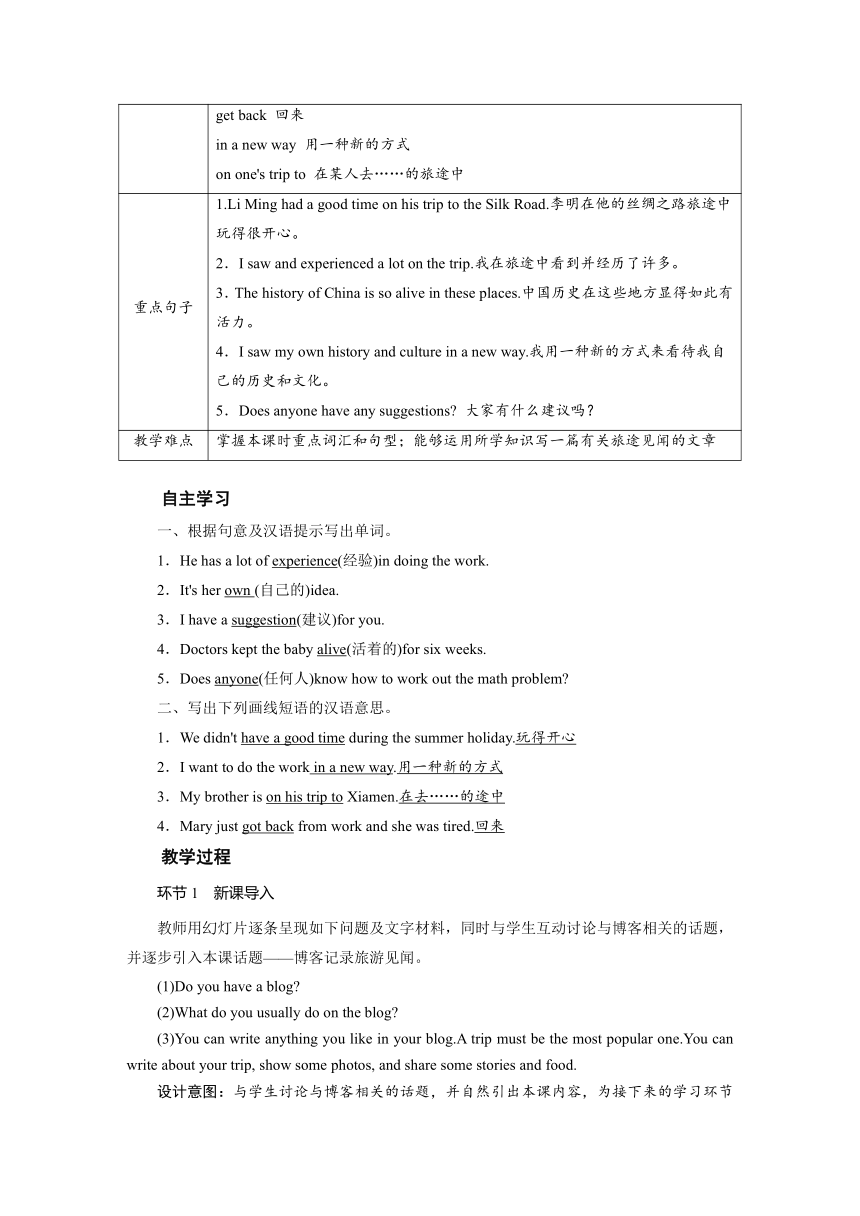Unit 2 It's Show Time! Lesson 12 A Blog about the Silk Road教案
文档属性
| 名称 | Unit 2 It's Show Time! Lesson 12 A Blog about the Silk Road教案 |  | |
| 格式 | doc | ||
| 文件大小 | 54.5KB | ||
| 资源类型 | 教案 | ||
| 版本资源 | 冀教版 | ||
| 科目 | 英语 | ||
| 更新时间 | 2021-06-11 07:23:28 | ||
图片预览


文档简介
Lesson12 A Blog about the Silk Road
教学目标
知识与能力目标
重点单词: experience, alive, own, should, anyone, suggestion
重点词组: have a good time, have a very long history, a lot, the history of China, open one’s eyes, in a new way
重点句式: ①Li Ming had a good time on his trip to the Silk Road.
②He wants to write about his trip.
③I just got back from a great trip to the Silk Road.
④My friends from Canada went with me.
⑤The history of China is so alive in these places.
⑥This trip opened my eyes.
⑦I saw my own history and culture in a new way.
过程与方法
了解英语博客的表达方式。
情感态度与价值观
通过阅读博客, 更深入地了解中国的名胜古迹, 增强学生的民族自豪感。
重难点:
重点:
1. experience 和 anyone 的用法。
2. 一般过去时态, 会运用一般过去时描述过去发生的故事
难点:
学会日记的英语表达方法
课时目标
重点单词 experience v.&n. 体验;经历;经验
alive adj. 活着的;有活力的
own adj. 自己的
should v.aux. 应该;将要
anyone pron.任何人;无论谁
suggestion n.建议
重点短语 have a good time 玩得开心
get back 回来
in a new way 用一种新的方式
on one's trip to 在某人去……的旅途中
重点句子 1.Li Ming had a good time on his trip to the Silk Road.李明在他的丝绸之路旅途中玩得很开心。
2.I saw and experienced a lot on the trip.我在旅途中看到并经历了许多。
3.The history of China is so alive in these places.中国历史在这些地方显得如此有活力。
4.I saw my own history and culture in a new way.我用一种新的方式来看待我自己的历史和文化。
5.Does anyone have any suggestions? 大家有什么建议吗?
教学难点 掌握本课时重点词汇和句型;能够运用所学知识写一篇有关旅途见闻的文章
自主学习
一、根据句意及汉语提示写出单词。
1.He has a lot of experience(经验)in doing the work.
2.It's her own (自己的)idea.
3.I have a suggestion(建议)for you.
4.Doctors kept the baby alive(活着的)for six weeks.
5.Does anyone(任何人)know how to work out the math problem?
二、写出下列画线短语的汉语意思。
1.We didn't have a good time during the summer holiday.玩得开心
2.I want to do the work in a new way.用一种新的方式
3.My brother is on his trip to Xiamen.在去……的途中
4.Mary just got back from work and she was tired.回来
教学过程
环节1 新课导入
教师用幻灯片逐条呈现如下问题及文字材料,同时与学生互动讨论与博客相关的话题,并逐步引入本课话题——博客记录旅游见闻。
(1)Do you have a blog?
(2)What do you usually do on the blog?
(3)You can write anything you like in your blog.A trip must be the most popular one.You can write about your trip, show some photos, and share some stories and food.
设计意图:与学生讨论与博客相关的话题,并自然引出本课内容,为接下来的学习环节做好铺垫。
环节2 新课学习
1.教师让学生快速浏览教材第28页的李明的博客,了解其主旨大意。
2.教师播放活动1的录音,学生听李明的博客,完成活动1的练习,然后教师邀请几名学生分享自己的答案,最后全班一起订正答案。
3.教师让学生仔细阅读李明的博客,勾画出文中的重点单词、短语和句子,随后教师对其进行讲解。
4.教师让学生再次阅读课文,并完成活动2的练习。然后教师订正答案,并请几名学生朗读活动2中的短文。
5.小组活动。教师把学生分成几个小组,让各组讨论并回答活动3中的三个问题。然后教师让几个小组上台分享他们的成果,并给予点评。最后全班订正答案。
6.教师让学生根据活动4中给出的提示,写一篇关于自己的旅行见闻的邮件,并附上照片,在下节课上和其他学生一起分享。
7.要点点拨。
(1)Li Ming had a good time on his trip to the Silk Road.
①have a good time玩得开心,过得愉快。该短语相当于enjoy oneself/have fun。如:Look!The children are having a good time over there.看!孩子们正在那边玩得很开心。
②on one's trip to在某人去……的途中。其中to是介词,该短语后面要跟地点名词。如:My brother is on his trip to Xiamen.我哥哥正在去厦门的途中。
(2)The history of China is so alive in these places.
【辨析】alive、lively、living与live
alive 意为“活着的”。它既可指人,也可指物。它可用来作表语、后置定语或宾补。
lively 意为“活泼的,活跃的,充满生气的”。它既可指人,又可指物。它可作定语、表语或宾补。
living 意为“活着”,强调“健在”,可用来指人或物,作定语或表语。常用短语:the living 活着的人;make a living 谋生;make a/one's living by+ v.?ing 通过做……谋生。
live 意为“活着的”。它通常指物,不指人,常放在名词的前面作定语。另外,它还可意为“实况转播的”。
(3)Does anyone have any suggestions?
suggestion作名词,意为“建议”。它是一个可数名词。常用结构:make a suggestion提出建议;give suggestions to给……提建议。如:My teacher gave me some suggestions on how to learn English.我的老师给了我一些学英语的建议。
8.学以致用。(单项选择)
( C )(1)—My parents and I will have a picnic this week.
—Really? ________ .
A.I don't think so B.That's very strange
C.Have a good time D.You should try it
( C )(2)—What a good ________ you gave me!Thanks a lot.
—My pleasure.
A.information B.news
C.suggestion D.advice
( B )(3)His grandmother died ten years ago, but his grandfather is still ________ .
A.live B.alive
C.lively D.lived
设计意图:通过小组活动,可以培养学生的团体协作能力;通过写作练习,可以提升学生综合运用语言的能力。
板书设计
Unit 2 It's Show Time! Lesson 12 A Blog about the Silk Road
experience,alive,own, should, anyone, suggestion,have a good time,get back,in a new way ,on one's trip to... Li Ming had a good time on his trip to the Silk Road.
The history of China is so alive in these places.
Does anyone have any suggestions?
教学目标
知识与能力目标
重点单词: experience, alive, own, should, anyone, suggestion
重点词组: have a good time, have a very long history, a lot, the history of China, open one’s eyes, in a new way
重点句式: ①Li Ming had a good time on his trip to the Silk Road.
②He wants to write about his trip.
③I just got back from a great trip to the Silk Road.
④My friends from Canada went with me.
⑤The history of China is so alive in these places.
⑥This trip opened my eyes.
⑦I saw my own history and culture in a new way.
过程与方法
了解英语博客的表达方式。
情感态度与价值观
通过阅读博客, 更深入地了解中国的名胜古迹, 增强学生的民族自豪感。
重难点:
重点:
1. experience 和 anyone 的用法。
2. 一般过去时态, 会运用一般过去时描述过去发生的故事
难点:
学会日记的英语表达方法
课时目标
重点单词 experience v.&n. 体验;经历;经验
alive adj. 活着的;有活力的
own adj. 自己的
should v.aux. 应该;将要
anyone pron.任何人;无论谁
suggestion n.建议
重点短语 have a good time 玩得开心
get back 回来
in a new way 用一种新的方式
on one's trip to 在某人去……的旅途中
重点句子 1.Li Ming had a good time on his trip to the Silk Road.李明在他的丝绸之路旅途中玩得很开心。
2.I saw and experienced a lot on the trip.我在旅途中看到并经历了许多。
3.The history of China is so alive in these places.中国历史在这些地方显得如此有活力。
4.I saw my own history and culture in a new way.我用一种新的方式来看待我自己的历史和文化。
5.Does anyone have any suggestions? 大家有什么建议吗?
教学难点 掌握本课时重点词汇和句型;能够运用所学知识写一篇有关旅途见闻的文章
自主学习
一、根据句意及汉语提示写出单词。
1.He has a lot of experience(经验)in doing the work.
2.It's her own (自己的)idea.
3.I have a suggestion(建议)for you.
4.Doctors kept the baby alive(活着的)for six weeks.
5.Does anyone(任何人)know how to work out the math problem?
二、写出下列画线短语的汉语意思。
1.We didn't have a good time during the summer holiday.玩得开心
2.I want to do the work in a new way.用一种新的方式
3.My brother is on his trip to Xiamen.在去……的途中
4.Mary just got back from work and she was tired.回来
教学过程
环节1 新课导入
教师用幻灯片逐条呈现如下问题及文字材料,同时与学生互动讨论与博客相关的话题,并逐步引入本课话题——博客记录旅游见闻。
(1)Do you have a blog?
(2)What do you usually do on the blog?
(3)You can write anything you like in your blog.A trip must be the most popular one.You can write about your trip, show some photos, and share some stories and food.
设计意图:与学生讨论与博客相关的话题,并自然引出本课内容,为接下来的学习环节做好铺垫。
环节2 新课学习
1.教师让学生快速浏览教材第28页的李明的博客,了解其主旨大意。
2.教师播放活动1的录音,学生听李明的博客,完成活动1的练习,然后教师邀请几名学生分享自己的答案,最后全班一起订正答案。
3.教师让学生仔细阅读李明的博客,勾画出文中的重点单词、短语和句子,随后教师对其进行讲解。
4.教师让学生再次阅读课文,并完成活动2的练习。然后教师订正答案,并请几名学生朗读活动2中的短文。
5.小组活动。教师把学生分成几个小组,让各组讨论并回答活动3中的三个问题。然后教师让几个小组上台分享他们的成果,并给予点评。最后全班订正答案。
6.教师让学生根据活动4中给出的提示,写一篇关于自己的旅行见闻的邮件,并附上照片,在下节课上和其他学生一起分享。
7.要点点拨。
(1)Li Ming had a good time on his trip to the Silk Road.
①have a good time玩得开心,过得愉快。该短语相当于enjoy oneself/have fun。如:Look!The children are having a good time over there.看!孩子们正在那边玩得很开心。
②on one's trip to在某人去……的途中。其中to是介词,该短语后面要跟地点名词。如:My brother is on his trip to Xiamen.我哥哥正在去厦门的途中。
(2)The history of China is so alive in these places.
【辨析】alive、lively、living与live
alive 意为“活着的”。它既可指人,也可指物。它可用来作表语、后置定语或宾补。
lively 意为“活泼的,活跃的,充满生气的”。它既可指人,又可指物。它可作定语、表语或宾补。
living 意为“活着”,强调“健在”,可用来指人或物,作定语或表语。常用短语:the living 活着的人;make a living 谋生;make a/one's living by+ v.?ing 通过做……谋生。
live 意为“活着的”。它通常指物,不指人,常放在名词的前面作定语。另外,它还可意为“实况转播的”。
(3)Does anyone have any suggestions?
suggestion作名词,意为“建议”。它是一个可数名词。常用结构:make a suggestion提出建议;give suggestions to给……提建议。如:My teacher gave me some suggestions on how to learn English.我的老师给了我一些学英语的建议。
8.学以致用。(单项选择)
( C )(1)—My parents and I will have a picnic this week.
—Really? ________ .
A.I don't think so B.That's very strange
C.Have a good time D.You should try it
( C )(2)—What a good ________ you gave me!Thanks a lot.
—My pleasure.
A.information B.news
C.suggestion D.advice
( B )(3)His grandmother died ten years ago, but his grandfather is still ________ .
A.live B.alive
C.lively D.lived
设计意图:通过小组活动,可以培养学生的团体协作能力;通过写作练习,可以提升学生综合运用语言的能力。
板书设计
Unit 2 It's Show Time! Lesson 12 A Blog about the Silk Road
experience,alive,own, should, anyone, suggestion,have a good time,get back,in a new way ,on one's trip to... Li Ming had a good time on his trip to the Silk Road.
The history of China is so alive in these places.
Does anyone have any suggestions?
同课章节目录
- Unit 1 A Trip to the Silk Road
- Lesson 1 A Trip to China
- Lesson 2 Meet You in Beijing
- Lesson 3 A Visit to Xi'an
- Lesson 4 A Visit to Lanzhou
- Lesson 5 Another Stop along the Silk Road
- Lesson 6 Jenny's Diary
- Unit 2 It's Show Time!
- Lesson 7 What's Your Project about?
- Lesson 8 Marco Polo and the Silk Road
- Lesson 9 Danny's School Project
- Lesson 10 Music and Dance
- Lesson 11 Food in China
- Lesson 12 A Blog about the Silk Road
- Unit 3 School Life
- Lesson 13 How Is School Going?
- Lesson 14 Jenny's School Life
- Lesson 15 Making a Difference
- Lesson 16 We Are with You!
- Lesson 17 School Science Fai
- Lesson 18 Teaching in China
- Unit 4 After-School Activities
- Lesson 19 A Dinner Date
- Lesson 20 Join Our Club!
- Lesson 21 What Is Your Club Type?
- Lesson 22 Big Plans for the Weekend
- Lesson 23 A Weekend with Grandma
- Lesson 24 How was Your Weekend?
- Unit 5 I Love Learning English!
- Lesson 25 A Phone Friend
- Lesson 26 Online Phone Calls
- Lesson 27 Amazing English
- Lesson 28 How Do I Learn English?
- Lesson 29 A Door to the World
- Lesson 30 Writing an E-mail in English
- Unit 6 Seasons
- Lesson 31 What Strange Weather!
- Lesson 32 I Can't Wait for Winter!
- Lesson 33 Kim's Favourite Season
- Lesson 34 Steven's Report
- Lesson 35 Surfing in Sydney
- Lesson 36 Spring in China
- Unit 7 Sports and Good Health
- Lesson 37 You Are What You Eat!
- Lesson 38 Stay Healthy!
- Lesson 39 Danny's Report
- Lesson 40 Move Your Body
- Lesson 41 Were People Healthy Then?
- Lesson 42 Know Yourself
- Unit 8 Summer Holiday Is Coming!
- Lesson 43 Have a Good Summer!
- Lesson 44 Volunteering in Summe
- Lesson 45 Baseball Season
- Lesson 46 Get Ready for Summer Holiday!
- Lesson 47 Summer Plans
- Lesson 48 Li Ming's Summer Holiday
